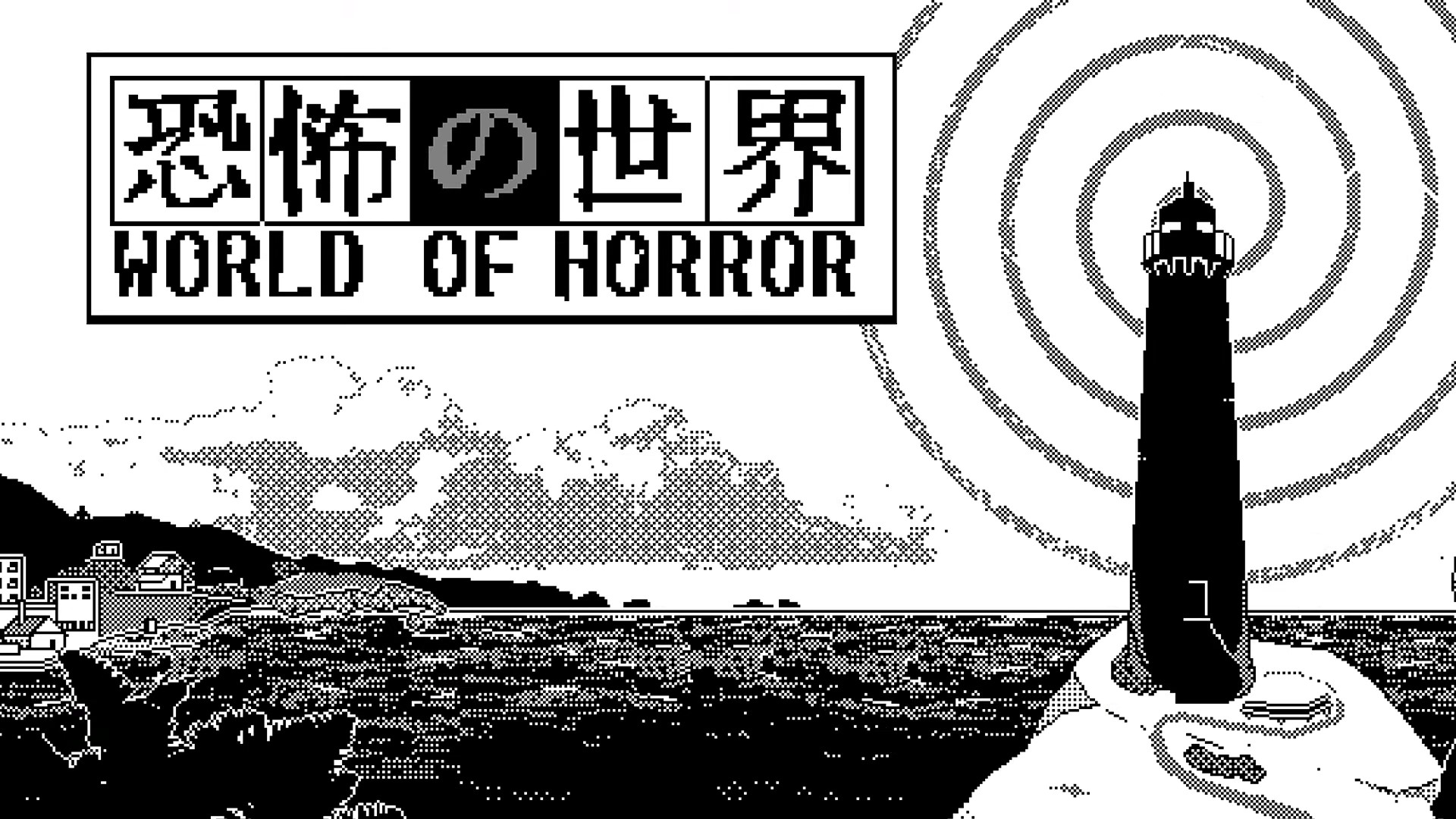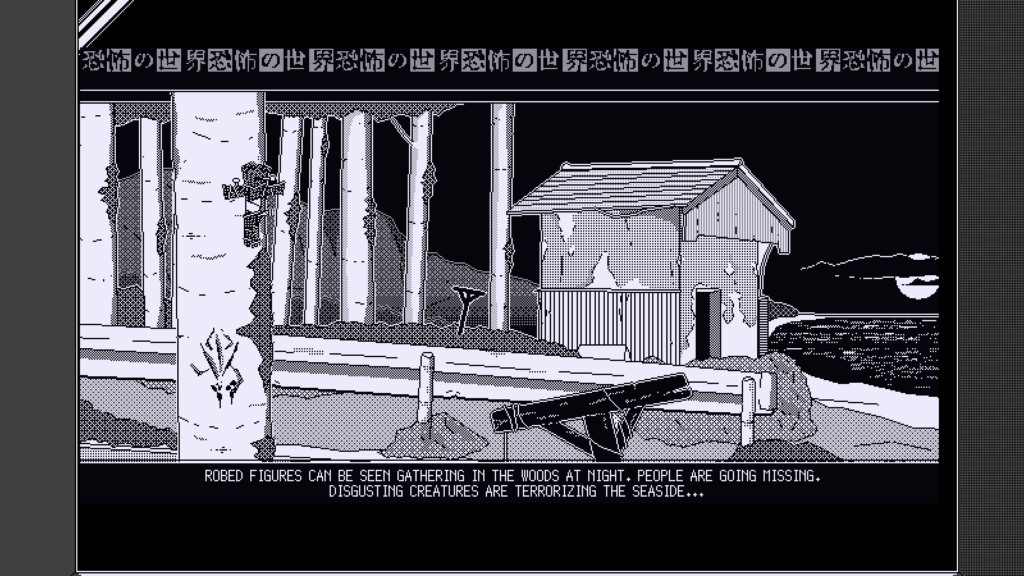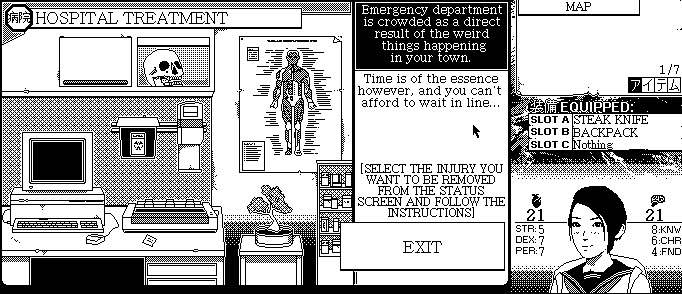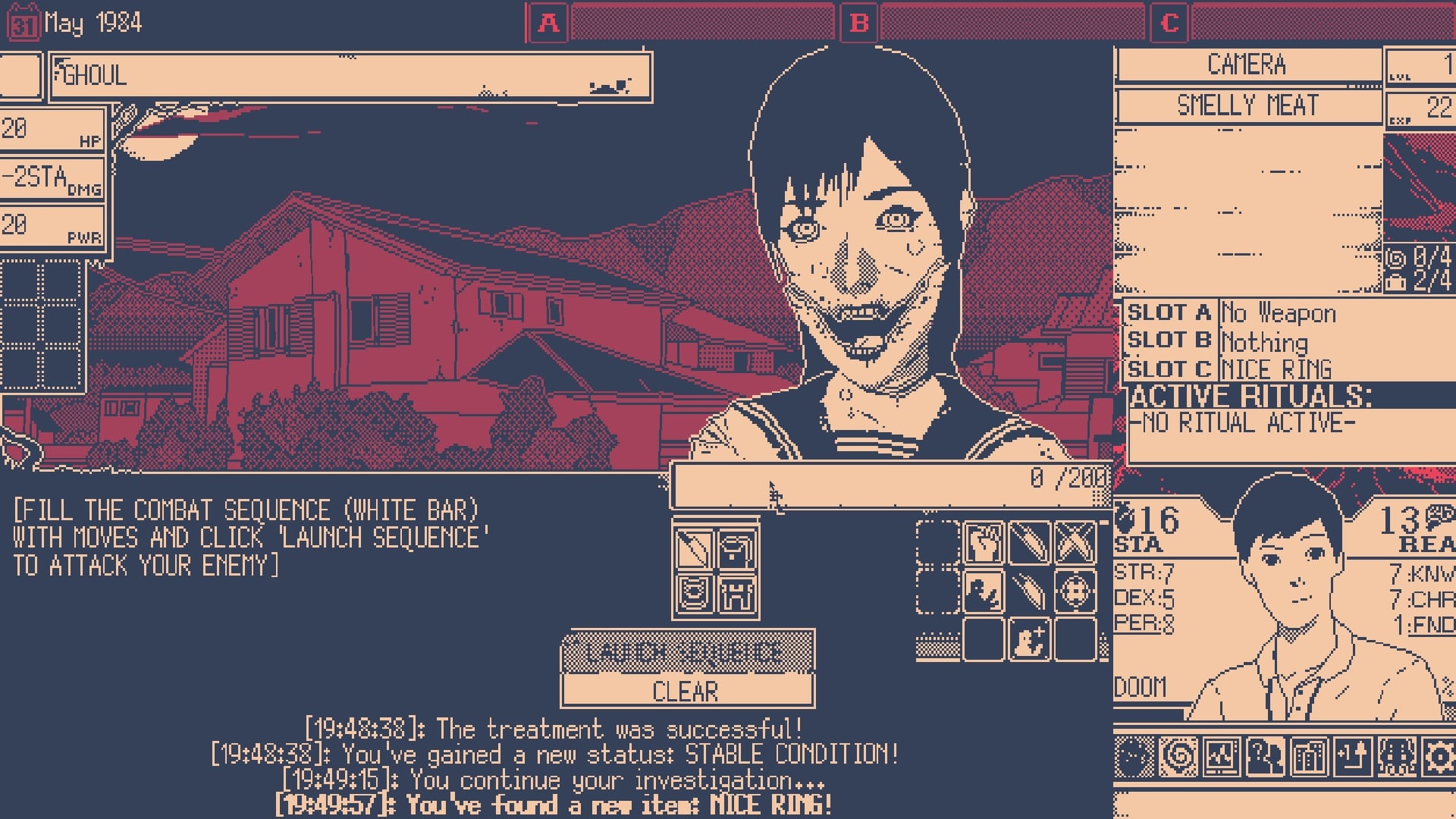
With a retro approach to rudimentary mechanics, and grim pixelated presentation, World of Horror is a passionate tribute to J-Horror; notably towards the eminent horror mangaka ‘Junji Ito’ who specializes in grotesque body horror. With all kinds of quirky protagonists as ‘investigators’, whether the more hardboiled Lovecraftian private eye in a noir fashion or an innocent schoolgirl in sailor fuku as quirky fun, these engage engrossing macabre cases full of familiar but subtle references blending into a charmingly esoteric environment.
The Game is currently in development at the stage of ‘Early Access’ by ‘Panstasz’ (Paweł Koźmiński) and published by Ysbryd Games, still expanding in scope with every update. It is best described as an interactive investigative narrative with folk and cosmic horror as the key themes for a unique angle to conventional horror.
Anchorhead, Ghost Stories and Elder Signs all proved a graphically intensive experience is unnecessary ahead of an overarching atmosphere and aesthetic – the latter providing formulating visceral scenery to imagination. As one unravels the darkness underneath the innocuous town increasingly cursed, where injuries may cause permanent effects on the playthrough (e.g. broken jaw, frostbite, scars), it is clear there will be many harsh and ruinous lessons to finally have some clarity, even satisfaction. No struggle against such powerful forces will be straightforward, success arbitrary in mercy as the RNG inherent.

“Armed with clues, spells, and your dwindling sanity, you’ll investigate mysteries across the city… and in realms beyond.”
You are situated in the seaside town (how New England-esque as with Uzumaki’s town) of Shiokawa in Japan and are tasked with investigating ‘Old Gods’ who’re causing all kinds of diabolical events in the town and must solve mysteries to progress a final objective. As the town descends into chaos, a doom counter, which is a brilliant Arkham Horror mechanic to measure the state of the world, exists to portray the discomforting decline of all and motivate urgency. Everything is affecting the big picture that contributes to the idea of being a small variable to a larger plot in a town beyond your full power.
The foremost pleasure, however, is immersing oneself in the intimately designed town. Full of vibrant character from the art direction, exploration is half the fun to the narrative, where each hostile encounter has such a personalized, chilling designs. The lore compels intrigue and compels the player into the depths of a unique universe. Your character is appropriately vulnerable in the brutal and inchoate adventure to effectively enhance the dread as all becomes more morbid. A powerless protagonist who’s desperately clawing for answers in mysteries as the town embroils all the people into madness and corrupts previously ordinary locales. There is no clear path or ultimate weapon.
Home is your comforting headquarters and here you will select a mystery to investigate as you explore a range of locales, like a hospitals to even a rural village, to have a variety of interesting encounters. These encounters frequently require basic choices, some needing special items or skill checks from attributes, to resolve these: an enthralling adventure into strange, weird events serving to build up the narrative. Although some events are redundant (i.e. discovering the corpse of a police officer) to the detriment of a dynamic world, it is nevertheless engaging for the duration of any original playthrough well worth the admission.
You will have allies, perks, spells, six attributes, special actions, rituals and items all complementing your adventure as the RPG framework (in this amalgamation of game genres from text-based RPG adventures to visual novels). Although these do enhance the experience thematically as pertinent to the lore, they are the weakest mechanic in terms of entertainment as slightly archaic. There will also be no complex and cohesive sequences of puzzles to achieve results as an elaborate system, it is much more simplistic as turn-based tactical combat with simple choices or utilizing special items/weapon.
Rituals, and sacred objects, are a fascinating perspective to exorcise particular enemies of certain properties, however, deserving more attention. You will balance the doom of the town, your sanity and stamina (as health) to feebly survive a relentless difficulty. One will be precariously using every lead and resource to resolve a plethora of crises emerging.

Survival horror has long indulged the tropes of cumbersome combat, unintuitively fickle puzzles and resource management to amplify the desperation from a reduction of power in honing any mechanics smoothly. World of Horror does this to a degree that does not override all else to become a hopeless annoyance. Knowledge of the world, too, as you learn mechanics is crucial for progression in a manner to integrate a cerebral overlay to contemplating the way forward – this will counteract the RNG sure to frustrate any tendency for power gaming.
As an investigative narrative experience, World of Horror combines two predominant spheres of horror icons, H. P. Lovecraft and Junji Ito, for a profound homage. It is an design of an intricate world augmented from their genius: an adventure in a stylish Japanese province, which follows a 80’s vibe for a groovy vaporwave feel from CRT monitors to Takumi’s AE86, that’s intriguing, unnerving and intense.
Although combat and survival may prove frustrating and incoherent, they are nevertheless secondary to the crafted world that’s a flawless framework to expand an evident focus, the interactive experience: a World of Horror. The framework has infinite potential for complex tales to engender a deep realm, spooky enemies to impose on the player’s imagination, unsettling items to lead curiosity of more knowledge and disturbing events to shape the atmosphere. This is ultimately a setup for a narrative horror sandbox unlike any other, the only limitation being the creativity for further story and art to depict these.

The respect for Japanese culture is also charmingly the perfect adaptation of quaint town life (this was an aspect Higurashi achieved brilliantly) in the architecture to the locales, culturally incorporating particular urban legends of the country for a tangible folklore. Additionally, this is more suitably modern in origin such as Kuchisake-onna and Aka Manto over the traditional, historic figures such as Yuki-onna or the yūrei of Botan Dōrō.
There will be pop cultural references throughout such as the meme hound of a Shiba Inu (who we know controls Silent Hill), Kiryu Kazuma of the Yakuza franchise as a universe that also created an intimate district we all love to revisit and an early CreepyPasta in Japan of the ‘the Red Room’ online. These are a cute fan service to delight anybody with likely interlinked interests to the nature of this product.
If you enjoy the world for the ambience and lore, repetition is no issue, especially considering procedural elements as in roguelikes where elements such as the Old God modify scenario variables, to learn more and explore deeper. Players will be rewarded with a variety of endings alongside disparate experiences in every playthrough. Modifiers are comprehensive, too, to alter the experience and experiment. These will sure be supplemented with modding in the future for a diverse experience in each run whereby the calculated narrative is the enticing surprise.
You have mystical items and narrative objects – each perfectly embedded into the world as relevant while not overbearing fantastically in motifs to breach the genre of magic realism – to aid your journey into this subtly esoteric world of the occult – carefully balanced between realism and the supernatural to not diverge from reality to an extent immersion (via relation to the world) is affected.
The colour palette schemes instill an array of visual flairs to flavor the experience, with accompanying eerie music distorting as all regresses. The stark contrast of black and white for a vintage terror like war-torn newsreel footage, sepia tones of yellow for a melancholic unease as with haunting ancient scrolls and a blood-soaked crimson interface for an odious ambience similar to Forbidden Siren(these are all key to the style as with the retro UI presented on a vintage television).
You will discover a vibrant town twisted and mangled as the monstrosities within while doom ups the ante as you desperately explore for clues to just maybe appease a situation spiraling into tragedy, with dread the only adjective to succinctly express the mood. Madness, death and destruction almost seem an inevitability in this brutal world. Relatively cheap and not demanding technically, World Of Horror is a captivating love letter to horror that I absolutely recommend supporting.
If you care to see Junji Ito adapted, and have any appreciation for inquisitive exploration in a detective fiction, this is without any doubt the experience you are seeking.
You can find out more about the game at the official site www.wohgame.com/.
More Game Reviews:
Confessions of a Serial Killer is a 1985 American horror thriller, written and directed by Mark Blair. Surprisingly, the film is the only writer/director credit to Mark’s name, never venturing…
I first saw Alejandro Jodorowsky’s surreal, bildungsroman film, Santa Sangre, in 1989 on VHS tape. Watching it was like watching a slasher about a killer with a twisted Oedipal Complex…
Born in 1946, Hideshi Hino stands out as a prominent Japanese horror artist, dedicating the majority of his life to conjuring various nightmares for his audience. Regrettably, in the Western…
Panorama of Hell is a 1984 Japanese horror one-shot manga, written and illustrated by Hideshi Hino. Known as a master horror mangaka, Hino is most notable as the writer/illustrator for…
Hey Mike Flanagan, we’ve found your next big project! New indie horror authors are crawling out of the woodwork every week, and just like indie films, their products are hit…
Thine Ears Shall Bleed is a 2024 American period horror, written and directed by Ben Bigelow, with additional writing from William Bigelow. Previously working as writer and director of the…
Regarded by many as Japan’s answer to Brigitte Bardot — both for her glamorousness and vaguely European looks (she wasn’t actually mixed-race) — Mari Atsumi became one of Japanese…
Well-known in the extreme cinema community, Brian Paulin is a writer/director/editor/actor/key make-up effects artist for the film production company Morbid Visions in addition to playing guitar, drums, and singing for…
In today’s world of flashy graphics and CGI, audiences have become immune to fantastical horror, pushing some writers to create content to test our boundaries with the extreme. In The…
The femme fatale is one of the most compelling and enduring archetypes in film history, captivating audiences with their blend of beauty, mystery, and danger. These enigmatic women are uniquely…
Some say the countdown begun when the first man spoke, others say it started at the Atomic Age. It’s the Doomsday Clock and we are each a variable to it.
Welcome to Carcosa where Godot lies! Surreality and satire are I.
I put the a(tom)ic into the major bomb. Tom’s the name!